Excerpts from Jim Conrad's
Naturalist Newsletter
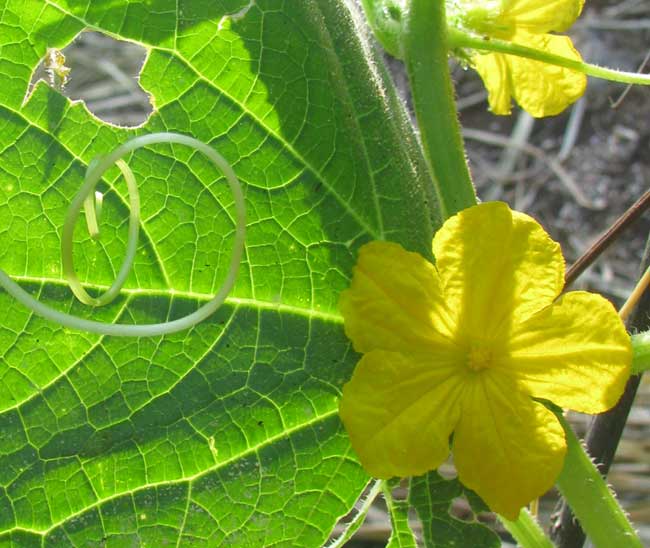
from the the June 13, 2010 Newsletter issued from Hacienda Chichen Resort beside Chichén Itzá ruins, central Yucatán, MÉXICO
CUCUMBER FLOWERS
We're developing an organic garden here and nowadays that's where I spend most of my volunteer time, which is fine with me. Not only does watching the garden develop day by day please me (I must be programmed to serve family and community by growing food for them so gardening gives me enormous satisfaction) but also it enriches my days esthetically.
For example, this week the cucumber vines began flowering. Just look at the pretty designs, textures and colors a little cucumber vine can produce, at the top of this page.
Think of being greeted by that in the cool early morning when dew still clings to the vines, the odor of freshly worked, rich, moist earth suffuses the air, robins are singing and chachalacas in the distance are calling, swallows are skimming the tall grass around you... And of course there's the thought that someday soon you may have sun-ripened cucumbers for your salads.
At first the vines produced only male flowers. I'm guessing that one reason for that is to habituate pollinators to visiting the vines for nectar, before the more valuable and more energy-demanding female flowers are produced.
An interesting feature of a cucumber vine's male flowers is that they are "syngenesious," which means that their baglike, pollen-producing anthers adhere to one another by their sides, so that all together a circle of anthers forms a closed cylinder. Also, at first glance each male cucumber blossom appears to bear only three anthers, but a closer look, with magnification, shows that in two cases two anthers are partly merged, so really there are the usual five anthers. Actually, these are all features of the entire Squash Family, the Cucurbitaceae, to which cucumber vines belong. I've torn away one side of a male cucumber flower to reveal the above features below:
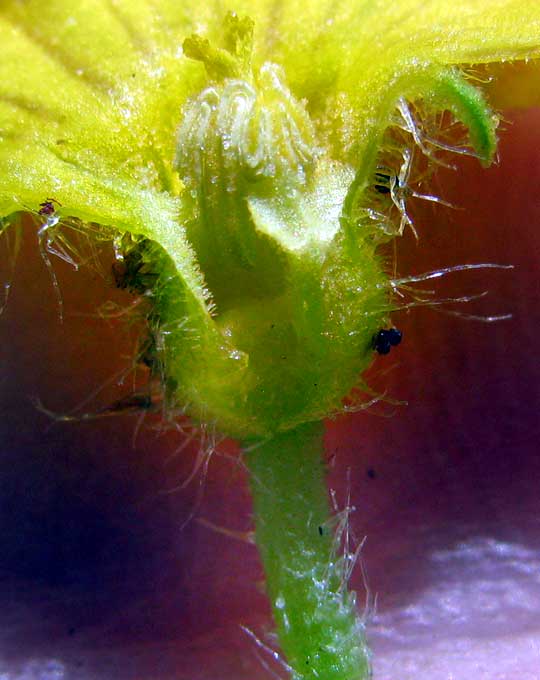
In that picture the anthers are the white-fuzz-outlined, banana-shaped items extending upward just beyond the throat of the corolla. At the right you can see an upward-pointing arrow motif, which is two of the anthers grown together. You might make out another such pair opposite it, and a single one-anthered stamen between them. The crownlike affair above the anthers is joined, twisted anther connective. One thing to notice about the male flower is that there's nothing there resembling a cucumber.
That's not the case with the female flower shown below:
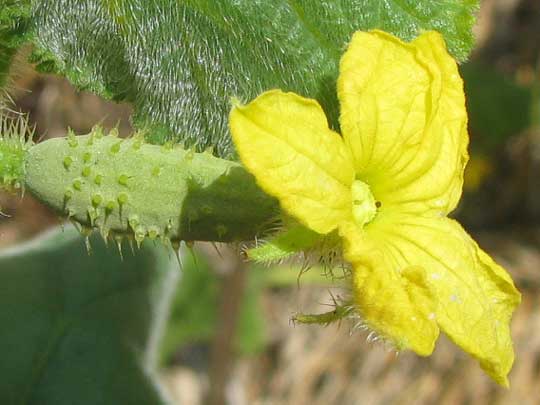
There the corolla and sepals arise atop the prickly inferior ovary, which is the future cucumber. Ovary and corolla are no more than an inch long (2.5 cm) so that ovary has a long way to go before it's a cucumber.
The big Squash Family embraces not only many kinds of squashes and cucumbers but also pumpkins, gourds, watermelons, and many other things most of us have never heard of (squirting-cucumbers and balsam-pears, for instance), so what features distinguish the cucumber species from all others?
Unlike gourds, cucumbers are "pepos" -- fleshy, mostly edible fruits that don't split when mature. Unlike the spiny, one-seeded squash much eaten down here, the chayote, which also is a pepo, cucumbers contain many seeds. Unlike squash and pumpkin flowers, whose corollas are bell-shaped with grown-together corolla lobes, cucumber corolla lobes are separate from one another almost or quite to their bases. There are some other technical details, but another distinguishing feature of cucumber vines is that their tendrils are "simple " -- instead of being branched as in some genera. Tendrils of vines of pumpkins and squash, for instance, are branched.
from the December 9, 2012 Newsletter issued from the valley of the Dry Frio River in northern Uvalde County, southwestern Texas, on the southern border of the Edwards Plateau; elevation ~1750m (~5750 ft); N29.62°, W99.86°; USA
CUCUMBER PRICKLES
Cucumber vines produce separate male and female flowers. Below you can see the calyx and corolla on female flowers there are 3/8ths-inch long (10mm) inferior ovaries, -- the future cucumbers
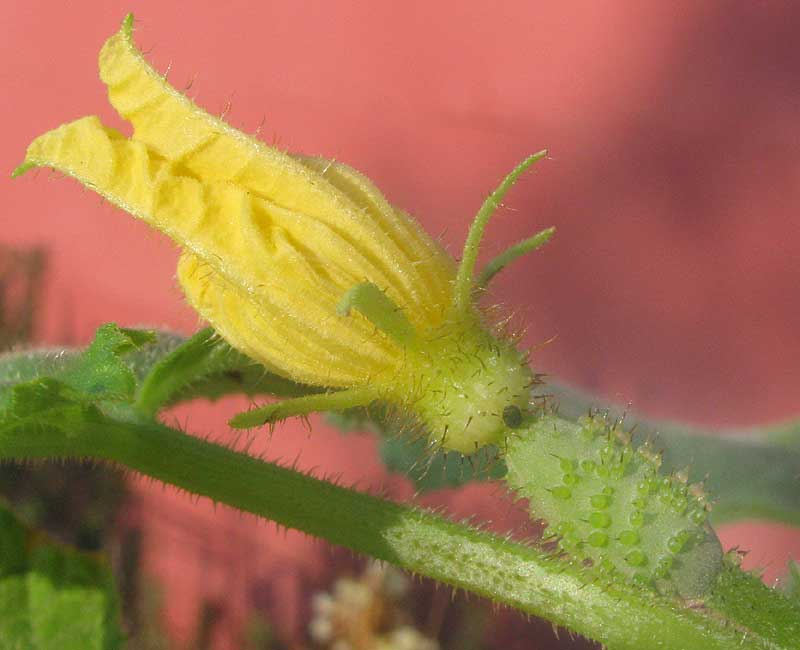
An interesting feature of that photo is that the green baby cucumber is covered with green, oval, spine tipped items. You've probably felt these "cucumber spines" on garden-grown cucumbers. They easily come off by brushing the cucumber with a cloth or the hand. A closer look at them -- with a blackish aphid at the cucumber's top -- is shown below:
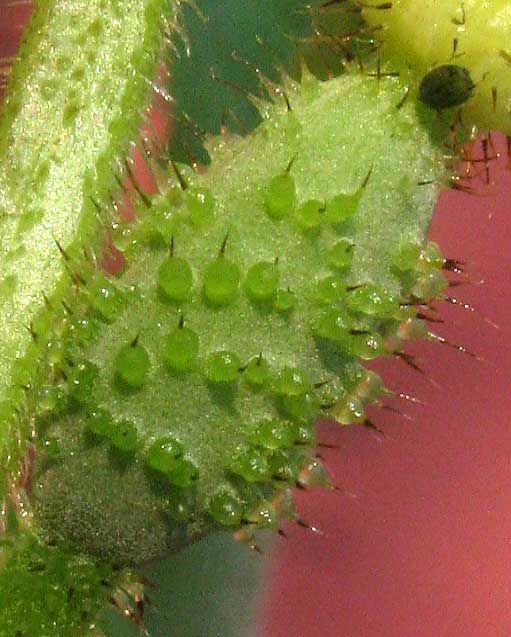
An even closer look at the spines, through a dissecting scope, is seen below:
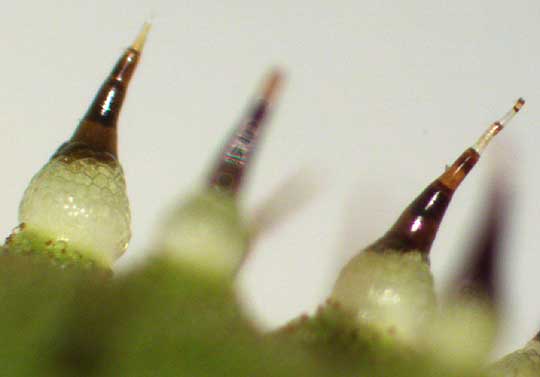
These spines with bulging bases are similar to those we've seen on wild plants where the bases contain a substance capable of repelling herbivores. When the herbivore breaks off the slender neck, the substance is released, maybe the base of the broken off slender neck even serving as a hypodermic needle inserting the substance into the herbivore's flesh.
It's hard to say with certainty that this is the function of spines on today's cucumbers, though, since cucumbers have been cultivated for about 3000 years and today's cultivars are much changed from the wild stock. However, it's known that the spines of today's cucumbers contain concentrations of a group of compounds known as cucurbitacins, which are toxic and can deter herbivores. Various cucurbitacins are responsible for the bitterness in some cucumbers.
Often cucumber cultivars are distinguished by whether their fruits bear white or black spines. Vines producing large fruits usually used for slicing and pickling typically bear white spines, while vines with smaller fruits normally used only for pickling usually bear black spines. The ones in our picture appear to be white spines.